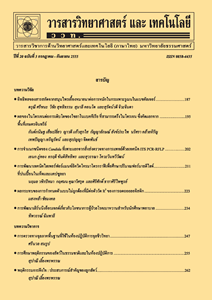การเลือกตัวแบบพยากรณ์ผลผลิตการเกษตรที่เหมาะสม
Main Article Content
Abstract
บทคัดย่อ
งานวิจัยนี้มีวัตถุประสงค์เพื่อศึกษาวิธีการพยากรณ์ผลผลิตการเกษตรของพืช 4 ชนิด ได้แก่ ข้าวนาปี ข้าวนาปรัง มันสำปะหลัง และสับปะรด ในจังหวัดที่มีผลผลิตสูงสุด 3 อันดับแรกของประเทศ และเลือกวิธีการพยากรณ์ผลผลิตการเกษตรที่เหมาะสม โดยเปรียบเทียบผลการพยากรณ์ของวิธีการพยากรณ์เชิงสาเหตุ 3 วิธี คือ วิธีการวิเคราะห์การถดถอยเชิงเส้น ระบบผสมของขั้นตอนวิธีทางพันธุกรรมและการวิเคราะห์การถดถอยเชิงเส้น และวิธีโครงข่ายประสาทเทียม ความแม่นยำของการพยากรณ์จะถูกเปรียบเทียบโดยใช้ค่าร้อยละความคลาดเคลื่อนสัมบูรณ์เฉลี่ย จากนั้นนำผลการพยากรณ์ที่ได้ไปเปรียบเทียบกับค่าพยากรณ์ของศูนย์สารสนเทศการเกษตร สำนักงานเศรษฐกิจการเกษตร กระทรวงเกษตรและสหกรณ์ เพื่อคัดเลือกตัวแบบการพยากรณ์ที่แม่นยำที่สุด จากผลการศึกษาพบว่าวิธีโครงข่ายประสาทเทียมให้ค่าร้อยละความคลาดเคลื่อนสัมบูรณ์เฉลี่ยต่ำที่สุดในพืชทุกชนิด โดยข้าวนาปีมีค่าร้อยละความคลาดเคลื่อนสัมบูรณ์เฉลี่ยอยู่ในช่วง 4.07 ถึง 8.56 เปอร์เซ็นต์ ข้าวนาปรังมีค่าร้อยละความคลาดเคลื่อนสัมบูรณ์เฉลี่ยอยู่ในช่วง 6.51 ถึง 9.30 เปอร์เซ็นต์ มันสำปะหลังมีค่าร้อยละความคลาดเคลื่อนสัมบูรณ์เฉลี่ยอยู่ในช่วง 4.46 ถึง 9.57 เปอร์เซ็นต์ และสับปะรดมีค่าร้อยละความคลาดเคลื่อนสัมบูรณ์เฉลี่ยอยู่ในช่วง 6.91 ถึง 8.67 เปอร์เซ็นต์
คำสำคัญ : การพยากรณ์; ผลผลิตการเกษตร; วิธีพยากรณ์เชิงสาเหตุ
Abstract
This research’s objective is to study the forecasting methods for the agricultural yields of four crops including in-season rice, off-season rice, cassava and pineapple in the provinces with the three highest yields of the country. Then the appropriate forecasting methods are selected by comparing the forecasting results from three causal methods including linear regression analysis, genetic algorithm-linear regression analysis hybrid system and artificial neural network. The forecast accuracies are compared by mean absolute percentage error (MAPE). After that the forecasting results are compared with the forecasts from the Center of Agricultural Information, Office of Agricultural Economics, Ministry of Agriculture and Cooperatives, in order to select the most accurate forecasting models. The results of the study show that the artificial neural network method provides the lowest MAPE in all crops such that the MAPEs of in-season rice ranged from 4.07 to 8.56 percent, the MAPEs of off-season rice ranged from 6.51 to 9.30 percent, the MAPEs of cassava ranged from 4.46 to 9.57 percent and the MAPEs of pineapple ranged from 6.91 to 8.67 percent.
Keywords: forecasting; agricultural yield; causal method


